Brussels – After an analysis of the decision comes the response from Brussels. “The European Union takes note of the Regulation of the Central Bank of Kosovo” on transparency and stability of financial flows and on combating money laundering and counterfeiting, with “concerns” about the consequences of the introduction of the exclusive use of the euro “on the daily life of Kosovo Serbs and other communities” in the country, “due to the absence of prior consultation,” European External Action Service (EEAS) spokesman Peter Stano said as the Regulation came into force from February 1.
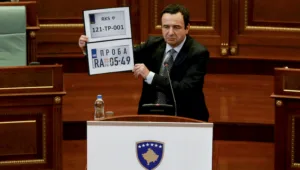
According to Brussels, the most significant impact of the Regulation on the “financial support that Kosovo Serbs receive from Serbia” will be on “schools and hospitals, given the apparent absence of alternatives at this time.” Kosovo’s Constitution provides for the exclusive use of the euro as an exchange currency and a deposit in bank accounts. The Regulation sets the modalities for its implementation, prohibiting any lender from operating without a license (as is currently the case with Postanska Stedionica, the Serbian intermediary for funds from Belgrade for some 90,000 Serbs in Kosovo). It does not affect voluntary transactions between parties using currencies other than the euro are: in other words, one can still trade the Serbian dinar, the Albanian lek or the dollar. However, the decision will impact the Serb-majority northern regions of the country, where some banks and public services exclusively use the Serbian dinar as their currency, never having adjusted to Pristina’s adoption of the euro in 2002 (even before independence).
After the end of the license plate dispute that inflamed the last two and a half years of relations between Serbia and Kosovo, Pristina’s partners — including the EU with its special representative for the Belgrade-Pristina dialogue, Miroslav Lajčák — in recent days called for at least a delay of the decision. Instead, Serbia’s president, Aleksandar Vučić, warned that he will use “all available means against banning the dinar in Kosovo” (although this is a non-factual interpretation of reality), involving directly the European Commission President Ursula von der Leyen: “I asked that she use all her strength and energy to make sure that such a thing does not happen.” But Kosovo’s premier, Albin Kurti, reiterated that the new rules “are non-negotiable” and that “we don’t want to punish anyone. We just want to bring back legality, constitutionality, and regularity” even in the north of the country. Kosovo’s president, Vjosa Osmani, clarified that the Rules will give “some time” to transfer funds in Serbian dinars to other euro accounts, with “several options” to implement of the new financial regime.
 SEE spokesman Stano stressed, however, that “the short transition period” for the implementation of the Regulation and the “lack of information and practical solutions for all affected communities” risks “seriously complicating” the lives of citizens. The Union urges Kosovo to “ensure a sufficiently long transition period,” and to “find a negotiated solution to this problem within the EU-facilitated dialogue” between Pristina and Belgrade. Brussels is struggling to manage tensions between the two countries after the high hopes at the beginning of 2023 – the February 27 Brussels Agreement defined the specific commitments, and the understanding on implementation annex was reached in Ohrid on March 18 – and continued with increased diplomatic and field conflict.
SEE spokesman Stano stressed, however, that “the short transition period” for the implementation of the Regulation and the “lack of information and practical solutions for all affected communities” risks “seriously complicating” the lives of citizens. The Union urges Kosovo to “ensure a sufficiently long transition period,” and to “find a negotiated solution to this problem within the EU-facilitated dialogue” between Pristina and Belgrade. Brussels is struggling to manage tensions between the two countries after the high hopes at the beginning of 2023 – the February 27 Brussels Agreement defined the specific commitments, and the understanding on implementation annex was reached in Ohrid on March 18 – and continued with increased diplomatic and field conflict.
All the reasons for tension between Serbia and Kosovo
After the two meetings in the summer of 2021 between PM Kurti and President Vučić in Brussels, the so-called license plate dispute broke out in mid-September for the first time in northern Kosovo. Initially, it was a diplomatic dispute between Pristina and Belgrade related to the Kurti government’s decision to impose the change of license plates on Serbian vehicles entering Kosovo territory, used in large part by the Serbian minority in the country. EU mediation temporarily resolved the issue, but the lack of a final solution inflamed the second half of 2022: in late July, there were the first roadblocks and barricades by the most extremist parts of the Serb-Kosovar minority and two failed meetings between Vučić and Kurti in Brussels led to no break of the stalemate.
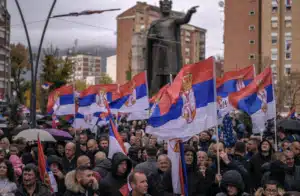
The situation worsened when Lista Sprska took over the reins of the popular protest in northern Kosovo. On November 5, there was a mass resignation of mayors, councilors, parliamentarians, judges, prosecutors, judicial personnel, and police officers from their respective national institutions in protest against the phased implementation of Serbian license plate replacement rules. Among those resigning were the mayors of Kosovska Mitrovica, Zubin Potok, Zvecan, and Leposavić, leading to the need to return to the polls in the four cities. On the night of November 23-24, a compromise solution was reached in Brussels, even though the Serbian president threatened to boycott the EU-Western Balkans summit in Tirana because of the appointment of Nenad Rašić in the Kosovo government (instead of the Lista Srpska leader Goran Rakić) as minister for Communities and Refugee Return. Rašić is the leader of the Democratic Progressive Party, a Serbian formation hostile to Belgrade.
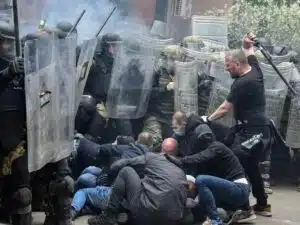
Clashes between Kosovo Serb protesters and NATO Kfor mission soldiers in Zvečan, May 29, 2023 (credits: Stringer / Afp)
2022 ended with a new escalation of tension at border crossings in northern Kosovo after Pristina’s sent several hundred police to make up for the lack of officers after their resignation also in November. They dismantled the barricades of the most extremist Serb-Kosovar flanks were only after a few weeks, thanks to the diplomatic effort of European and U.S. partners. A new crisis was only five months away, on May 26, 2023. As newly elected mayors of Zubin Potok, Zvečan, Leposavić, and Kosovska Mitrovica took office, violent clashes sparked by Lista Srpska exponents erupted, and, on May 29, they turned into a guerrilla warfare that also involved soldiers from the international NATO-led KFOR. Tensions erupted over the Kurti government’s decision to bring special police forces to allow mayors elected on April 23 to enter town halls in a controversial election round due to low voter turnout. On June 14, three Kosovar policemen were arrested/kidnapped by Serbian security services, with the governments of Pristina and Belgrade accusing each other’s law enforcement agencies of trespassing in a poorly controlled border area used by smugglers trying to avoid controls. After weeks of unheeded, continued calls for calm and de-escalation, Brussels convened an emergency meeting with PM Kurti and President Vučić to exit the “crisis management mode.” On June 22, Serbia released the three Kosovar policemen, but tensions between Pristina and Belgrade also ended up in the conclusions of the June 29-30 European Council.
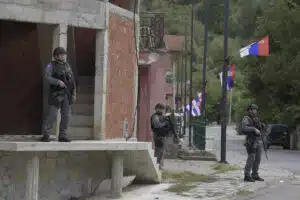
(credits: Armen Nimani / Afp)
Due to Pristina’s failure to take a “constructive attitude” toward de-escalating tension, Brussels imposed “temporary and reversible” measures against Kosovo in late June, which also included suspending the work of the bodies of the Stabilization and Association Agreement. A four-stage roadmap was agreed on July 12 to remove these measures, but they are still in effect. Within days of an unsuccessful high-level meeting in Brussels, however, the situation between Serbia and Kosovo escalated with the terrorist attack that began in the early hours of September 24 near the Serbian Orthodox monastery in Banjska, when Kosovo police arrived after a report of an illegal checkpoint on the border with Serbia. After killing one policeman and wounding two others, a group of about 30 armed men entered the monastic complex, and clashes continued throughout the day. During the “clearing operation,” three of the terrorists died.
Post-September 24 developments showed obvious ramifications in neighboring Serbia. As video filmed by a drone that day showed, among the attackers outside the monastery was Milan Radoičić, deputy head of Lista Srpska. On September 29, Radoičić himself confirmed that he led the armed attack in a confession that cast a long shadow not only over the participation of the Serb-Kosovar leadership in a strategy to destabilize the country but, more importantly, over Belgrade’s ability to interfere in Pristina’s internal affairs. In addition, there were revelations about the presence of Milorad Jevtić, a close associate of the Serbian president’s son, Danilo Vučić. According to the findings of an investigation by Balkan Insight, the weapons used in the attack were manufactured in Serbia in 2022, and some mortar shells and grenades were repaired in Serbian state maintenance centers in 2018 and 2021.
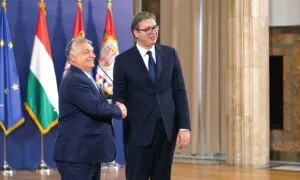
From left: the prime minister of Hungary, Viktor Orbán, and the president of Serbia, Aleksandar Vučić, in Belgrade (July 8, 2021)
Also worsening relations between Kosovo and Serbia was the U.S. warning of a Serbian “major military deployment” along the administrative border. The threat did not materialize –according to Prime Minister Kurti, an annexation of northern Kosovo was planned with “a coordinated attack on 37 separate positions” — but the European Union began to reflect on the possibility of imposing the same measures in force against Pristina against Belgrade. “We need to make sure that we make the best use of the tools the EU has to encourage both sides to contribute to a solution of the crisis,” EEAS spokesman Peter Stano explained to Eunews. But the green light for the measures against Serbia requires unanimity in the Council, and Vučić’s closest ally inside the Union – the Hungarian premier, Viktor Orbán – vetoed it. The only positive news for now is the resolution of the ‘battle of the license plates’ between Serbia and Kosovo, thanks to the decision between late 2023 and early 2024 on mutual recognition for vehicles entering the border.
Find more insights on the Balkan region in the newsletter BarBalcani hosted by Eunews
English version by the Translation Service of Withub









